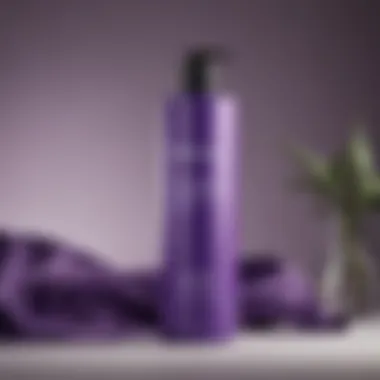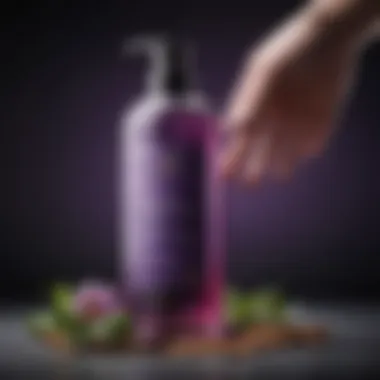Top Salon Purple Shampoos for Radiant Hair


Intro
Hair care has become a focal point in personal grooming, especially for those with color-treated hair. Women seek ways to maintain their vibrant hues while avoiding unwanted brassiness. In this context, purple shampoos have emerged as powerful tools. These specialized products are designed to neutralize Yellow and brassy tones in blonde and light-colored hair. This article explores the best salon-grade purple shampoos, focusing on their formulas, effectiveness, and various benefits.
The importance of ingredient transparency cannot be overstated. Understanding what goes into these products is essential for making informed choices. Hair types vary widely; therefore, it is crucial to know which purple shampoos are suitable for different textures and colors. The discussion will also cover application techniques and routines that enhance the efficacy of the products.
By the end of this guide, you will have a well-rounded understanding of the purple shampoos available in the market and how they can elevate your hair care regimen. The aim is to assist women aged 18 to 45 in making educated decisions for their color-treated hair.
Trending Topics
Current Fashion Trends
As trends in hair color shift frequently, many women gravitate towards blonder shades or lighter tones. These colors can give a refreshing look but require consistent maintenance to keep them vibrant. Purple shampoos have become fashionable not just for their practicality but also for how they enhance hair appearance. The trend isn't simply about color but ensuring that hair remains healthy and radiant.
Beauty Innovations
The beauty industry continuously evolves, and purple shampoos are no exception. Recently, various brands have introduced innovative formulas that promise better results with fewer washes. Ingredients like botanical extracts and nourishing oils are now prominent in these products. This shift acknowledges the need for dual functionality—maintaining color while also caring for hair health.
Step-by-Step Guides
Benefits of Purple Shampoo
- Neutralizes brassy tones: The primary function is to remove undesired yellow tones.
- Enhances vibrancy: It brightens blonde shades, making them look fresh.
- Repairs damage: Some formulations include reparative ingredients to strengthen hair.
Application Tips
- Wet your hair thoroughly. Ensure that your hair is completely saturated before applying the shampoo.
- Apply the shampoo evenly. Focus on the mid-lengths and ends, where brassiness tends to be more prominent.
- Leave for a few minutes. Depending on the brand, letting the shampoo sit for 2-5 minutes can yield better results.
- Rinse thoroughly. Make sure to wash out all product to avoid build-up.
- Follow with conditioner. A compatible conditioner will lock in moisture, enhancing overall hair health.
Product Reviews
In-Depth Analysis of Popular Items
When exploring this category, several products are often praised:
- Olaplex No. 4P: Known for its reparative qualities, it also neutralizes brassiness effectively.
- Joico Color Balance Purple Shampoo: Offers a balance of color correction and hydration.
Comparative Reviews
In comparing these shampoos, consider not only their effectiveness but also their ingredient lists and user feedback. Both Olaplex and Joico stand out for their unique formulas, but personal preference and hair type will ultimately guide choices.
"Choosing the right purple shampoo is an art, much like choosing the right shade for your hair. It's about finding the balance that works for you."
Understanding Purple Shampoo
Purple shampoo plays a crucial role in maintaining color-treated hair, especially for those with blonde, grey, or light shades. This type of shampoo is specifically formulated to counteract undesirable yellow or brassy tones that can accumulate over time due to environmental factors, heat styling, or chemical treatments. Understanding purple shampoo goes beyond knowing its basic function; it involves a deeper comprehension of how it integrates into a holistic hair care routine.
What is Purple Shampoo?
Purple shampoo is a cleansing product containing purple pigments. These pigments are designed to neutralize warm undertones in color-treated hair. The color purple sits opposite to yellow on the color wheel, meaning it effectively cancels out those unwanted brassy shades. Purple shampoo is not a dye; rather, it temporarily coats the hair to reduce the appearance of yellow hues.
How Purple Shampoo Works
The mechanism behind purple shampoo lies in its color theory. When applied to the hair, the purple pigments absorb into the strands, and this action neutralizes the brassy tones. However, the effectiveness hinges on how long the shampoo is left in the hair before rinsing. Typically, a few minutes is sufficient for the pigments to work their magic.
However, overexposure can lead to a violet tint, especially on very light blonde or grey hair. Therefore, understanding individual hair types is essential when using purple shampoo. This suggests that personalized application methods are ideal, enhancing its benefits while mitigating potential drawbacks.
Benefits of Using Purple Shampoo
There are numerous advantages to incorporating purple shampoo into a hair care regimen:


- Color Maintenance: Helps in maintaining the vibrancy of dyed hair by counteracting dullness and yellow tones.
- Enhanced Shine: Regular use can lead to shinier, more reflective hair, improving its overall appearance.
- Prolongs Color Life: Reduces the frequency of color treatments needed by preserving the integrity of highlights or dye jobs.
- Gentle Cleansing: Many purple shampoos are formulated to cleanse without stripping natural oils, keeping hair healthy.
Key Features of a Good Purple Shampoo
When selecting a purple shampoo, understanding the crucial features is vital for achieving the best results. A good purple shampoo effectively corrects unwanted brassiness, hydrates the hair, and maintains the overall health of color-treated locks. By focusing on these specific elements, one can ensure that chosen products deliver optimal performance while catering to individual hair needs.
Color Correcting Properties
Color correcting properties lie at the very heart of what purple shampoos are designed to do. The primary purpose is to neutralize brassy yellow tones that often develop in blonde or light-colored hair. This happens because purple is opposite yellow on the color wheel. When applied, the shampoo deposits violet pigments that balance out the unwanted warm hues. It is essential to pick a product with a sufficient concentration of these pigments to see noticeable results. Not all purple shampoos have the same intensity, so researching or testing different brands can provide insights into what works best for one's specific hair tone.
Ingredient Quality
The effectiveness of a purple shampoo is significantly influenced by the quality of its ingredients. High-quality ingredients ensure that the shampoo not only corrects color but also nourishes and protects the hair. Look for products that list nourishing oils, botanical extracts, or protein-rich complexes high on the ingredient list. Ingredients like coconut oil and argan oil can enhance shine and hydration. Always check for transparency about ingredient sourcing. Many consumers appreciate products that maintain a commitment to quality and sustainability.
Moisturizing Components
Moisturizing components play a significant role in maintaining the hair's health alongside its color. The nature of color-treated hair often leaves it more prone to dryness. A well-formulated purple shampoo should include moisturizing elements like glycerin and aloe vera. These ingredients help to retain moisture and ensure the hair remains hydrated after cleansing. The balance of cleansing and moisture is crucial to prevent brittle strands. In choosing a product rich in moisturizing components, one not only promotes color maintenance but also the overall texture and manageability of the hair.
Sulfate-Free Options
In recent years, sulfate-free shampoos have gained popularity, and for good reason. Sulfates can be harsh, stripping natural oils from the hair and scalp. For those with color-treated hair, this can lead to dullness or fading of the color. Selecting a sulfate-free purple shampoo can provide the benefit of gentler cleansing without compromising the vibrancy of one’s color. Many brands now offer sulfate-free formulas that effectively cleanse the hair while still providing that important purple toning effect. This choice is particularly advantageous for individuals with sensitive scalps or those who prioritize gentle hair care regimens.
In summary, a good purple shampoo should not only neutralize color but also support hair health through quality ingredients, moisturizing properties, and gentle formulas.
By considering these key features, consumers can make informed choices about their purple shampoo selections, leading to better-maintained hair and a more polished appearance.
Top Salon Purple Shampoos Reviewed
The evaluation of top salon purple shampoos is essential within this guide. A well-selected purple shampoo can significantly transform the appearance and health of color-treated hair, particularly for those who are blonde or have light shades. These products not only neutralize unwanted brassiness but also enhance the vibrancy of the hair color.
In this section, we will review the standout options based on specific factors such as their formulations, performance, and user experiences. It is vital to consider various elements when selecting a purple shampoo to ensure that it meets individual hair care needs.
Brand A: Overview and Performance
Brand A is known for its effective formula aimed at maintaining the integrity of blonde hair. The shampoo contains high-quality pigment designed to nullify brassy undertones. Users report that it delivers noticeable results after just a few washes. The texture is smooth and lathers well, ensuring easy application while providing a rich cleansing experience.
Performance-wise, users found that their hair felt softer and looked more luminous after consistent use. The ability to refine blonde tones without drying the hair is a notable advantage of Brand A.
Brand B: Unique Formulation
Brand B differentiates itself with a unique formulation that includes a blend of natural extracts and proteins. This shampoo not only fights brassiness but also strengthens the hair strands. The incorporation of coconut oil adds a moisturizing element that is critical for keeping colored hair healthy. Users appreciate the added benefits of hydration without compromising on the color-correcting effectiveness.
The scent of Brand B is another appealing aspect, reminiscent of fresh flowers, which enhances the overall experience during use. This brand is a suitable option for those looking for a holistic approach to their hair care routine.
Brand C: Customer Feedback
Brand C has received a wealth of positive customer feedback. Many users commend its ability to produce visible changes in a short time frame. The shampoo's gentleness is often highlighted, making it suitable for daily use without stripping the hair of its essential oils.
The collective experiences of users emphasize the value of Brand C in their hair care regimens. Many report that their color lasts longer, and their hair feels revitalized. Reviews indicate a strong recommendation for anyone seeking a dependable purple shampoo to maintain their color-treated hair.
"Investing in a quality purple shampoo like those from these brands can make a noticeable difference in overall hair health and color retention."
The next sections will further explore how to apply these products effectively and how they align with diverse hair types.
How to Use Purple Shampoo Effectively
Using purple shampoo correctly is vital to maintaining the vibrancy of color-treated hair. Many individuals may not realize that the application techniques and frequency can greatly affect the outcomes. This section will explore these factors in detail, emphasizing the significance of proper usage for optimal results.
Correct Application Techniques


To achieve the best results, proper application of purple shampoo is essential. Here are key steps to follow:
- Start with Wet Hair: Begin by thoroughly wetting your hair. This allows the shampoo to distribute evenly.
- Use the Right Amount: Depending on your hair length and thickness, use a sufficient amount of shampoo. A quarter-size dollop is often enough for medium-length hair.
- Apply Evenly: Work the shampoo into your hair starting from the scalp and moving towards the ends. It's crucial to cover all areas to ensure an even tone.
- Let It Sit: Allow the shampoo to remain in your hair for 2 to 5 minutes. This duration can be adjusted based on how brassy your hair appears. Monitor the time closely to avoid over-toning.
- Rinse Thoroughly: After the processing time is complete, rinse with lukewarm water. Make sure all the shampoo is washed out, as residue can lead to dullness.
By following these techniques, you can effectively neutralize unwanted yellow tones while refreshing your hair's overall color.
Frequency of Use
How often you use purple shampoo significantly influences hair maintenance. Here are some considerations:
- Hair Type: For individuals with coarse or dry hair, using purple shampoo once a week might suffice. Those with oily hair can use it more frequently.
- Color Treatment: If your hair is heavily color-treated, using purple shampoo once or twice a week is advantageous to keep brassiness at bay.
- Personal Preference: Adjust usage according to how often you feel your hair needs toning. Listen to your hair's needs.
Ultimately, a consistent routine tailored to your hair type will yield the best results.
Combining with Other Products
Integrating purple shampoo with other hair care products can enhance benefits. Consider these tips:
- Conditioners: Follow up with a moisturizing conditioner. Purple shampoo can be drying, so a good conditioner will help restore moisture to your hair.
- Leave-In Treatments: Use leave-in products designed for color-treated hair. This will help maintain softness and prevent damage.
- Heat Protectants: If you often style your hair with heat, using a heat protectant is crucial to safeguard against further color fading.
Combining these products will not only ensure the health of your hair but also maximize the effectiveness of your purple shampoo.
Proper application and routine can keep your color vibrant and your hair healthy.
Common Mistakes to Avoid
Understanding common mistakes when using purple shampoo is crucial for maximizing its benefits. Many users tend to overlook essential factors leading to less effective results. This section will provide insights on frequent errors and how avoiding them can lead to healthier, vibrant hair.
Overuse of Purple Shampoo
One of the most prevalent mistakes is the overuse of purple shampoo. Users often believe that applying it daily will quickly eliminate unwanted brassiness. However, using it too often can lead to a buildup of purple pigments in the hair. This can cause a dull or overly cool tone, which may not be flattering. Instead, it is advisable to limit its use to once or twice a week, depending on the brassiness of your hair.
Benefits of Moderation:
- Maintains Balance: Proper frequency helps maintain the natural balance of color in hair.
- Prevents Damage: Overuse can dry out the hair, leading to frizz and breakage.
- Enhances Effectiveness: Using purple shampoo sparingly keeps it effective in combating yellow tones.
Neglecting Hair Type Differences
Another significant mistake is failing to consider individual hair types. Purple shampoos can vary widely in formulation, which means not everyone will benefit from the same product. For instance, those with fine hair may find a lightweight, moisturizing purple shampoo more suitable, whereas thicker hair types might require a more intense treatment. Neglecting these differences can lead to unsatisfactory results.
Considerations:
- Fine Hair: Look for sulfate-free options that are hydrating.
- Thick or Curly Hair: Stronger formulations can help manage brassiness but require more moisture to prevent dryness.
- Color-Treated vs. Natural: Different formulations work best for different hair color treatments.
Incorrect Timing
Timing is also a crucial factor in the effective use of purple shampoo. Many users either leave it on for too short a time or far too long. Short applications may not allow enough time for the pigments to work effectively, resulting in insufficient color correction. Conversely, extended exposure can lead to an undesirable purple tint.
Best Practices:
- Follow Instructions: Each product will have specific timing recommendations.
- Test Strands: It can be helpful to perform a strand test to determine the optimal duration for conditioning.
- Observe Results: Pay attention to the color and health of your hair during use to adjust timing as necessary.
Understanding these common mistakes can significantly improve the use of purple shampoos, leading to better outcomes and healthier hair overall.
The Role of pH in Hair Care
Understanding pH is crucial for hair care, particularly for those using purple shampoos. The pH level indicates the acidity or alkalinity of a substance, measured on a scale of 0 to 14. Hair typically has a pH of around 4.5 to 5.5. Maintaining this balance is essential for overall hair health. An imbalance can lead to cuticle damage, making hair brittle and susceptible to breakage and frizz. This is especially important for color-treated hair, which is already prone to damage.
pH Balance and Hair Health


Maintaining pH balance is critical for preserving the integrity of hair. When hair is at its optimal pH level, it appears shinier and feels smoother. The hair cuticles lie flat, which helps reflect light better. This flattened state also keeps moisture from escaping, providing hydration and reducing dryness.
Hair products, including purple shampoos, can have varying pH levels. Using a product that is too alkaline can cause hair to swell. This leads to raised cuticles that can expose the inner layers of hair, resulting in porosity and loss of color. It is essential to choose shampoos that balance the pH to ensure healthier hair.
How pH Affects Color-Treated Hair
Color-treated hair requires special attention regarding pH levels. Hair dyeing processes often raise the pH of hair to allow color to penetrate. Afterward, it's crucial to lower the pH with suitable hair care products. If this step is neglected, the hair continues to be in an alkaline state, which can lead to faded color and dullness.
When using purple shampoos, the pH can play a role in how well the sulfate-free formulas work. A slightly acidic pH helps to maintain the desired color tone.
In summary, selecting hair products with the right pH levels can improve the appearance and longevity of color-treated hair. Understanding these properties leads to better choices, ensuring vibrant and healthy hair.
Environmental Considerations
The conversation around hair care products has expanded in recent years, turning towards environmental considerations. It's no longer just about the effectiveness of the product for maintaining hair color; how these products affect our planet has gained significant attention. Understanding this aspect is crucial for consumers who wish to align their beauty routines with sustainable practices. Thus, exploring the elements contributing to environmental considerations in the context of purple shampoos is essential.
Sustainability in Hair Care Products
Sustainability focuses on the ability to maintain ecological balance and find solutions that do not deplete resources. In hair care, this translates to using ingredients that are sourced responsibly. Many brands focus on eco-friendly practices, aiming to minimize their carbon footprint. They choose natural ingredients over synthetic ones, which can be harmful both to hair and the environment. For instance:
- Natural Sourcing: Selecting ingredients like lavender oil or chamomile, which promote healthy hair while being biodegradable, is becoming more common.
- Cruelty-Free: Many brands are now committed to not testing on animals, promoting ethical standards within the beauty industry.
Using purple shampoos that hold these values not only benefits your hair but also contributes to a healthier planet.
Packaging and Ingredients Impact
Packaging plays a significant role in the environmental impact of hair care products. Many shampoo brands are reevaluating their packaging strategies, striving to reduce plastic waste. Some have adopted recyclable and biodegradable materials for their bottles. This shift can significantly lessen the amount of plastic that ends up in landfills and oceans.
- Innovative Design: Brands like Amika and Olaplex are known for using sleek, minimalistic designs that reduce material waste while still being functional.
- Refillable Options: Some companies offer refillable containers, encouraging consumers to reuse rather than dispose.
The ingredients used in purple shampoos matter tremendously as well. Many conventional shampoos contain sulfates and parabens, which can be detrimental to hair health and the environment. Shifting to products with clean, non-toxic ingredients aligns with both personal health and environmental accountability.
"Choosing environmentally conscious shampoos means investing not just in your hair, but in the earth."
Consultation with Professionals
About hair care, especially when it comes to color-treated hair, consulting professionals is a critical aspect that should not be overlooked. Using purple shampoos can be effective; however, the individual hair structure, preferences, and unique color nuances make a one-size-fits-all approach insufficient. Professionals possess the knowledge and experience to provide personalized advice that enhances the hair care journey.
Consulting a stylist can guide you in selecting the right products tailored to your specific needs.
A professional can assess the current state of your hair and the color treatments you may have undergone. Understanding these specifics can help in recommending the most suitable purple shampoo. For example, some products are designed for fine hair, while others cater to thicker or coarser textures. Knowing which formulation complements your hair type is paramount for effective brassiness reduction.
Additionally, professional consultations can provide insight into the frequency of use necessary for optimal results. Stying experts often develop a customized maintenance regimen based on the client’s hair condition. This personalized touch can make a significant difference in how your hair responds to treatment.
Beyond just selecting the right product, stylists can illuminate potential interactions between different hair care products. For instance, combining certain products might not deliver the desired results. This degree of knowledge is something a home user may not typically possess.
In summation, consulting a stylist can not only streamline your hair care routine but also prevent common mistakes that occur with self-guided choices.
When to Seek Advice from a Stylist
Knowing when to consult a stylist can prevent various mishaps in hair treatment. If your hair starts appearing dull, brassy, or if you notice changes in texture after several treatments, these are good indicators.
Consider seeking advice in the following situations:
- Introduction of New Hair Color: If you have recently dyed your hair, discussing it with a stylist will clarify which purple shampoo suits your new shade.
- Changes in Hair Quality: Any noticeable changes in hair texture or quality may necessitate a professional opinion.
- Experimentation with Products: If you intend to mix products or try something new, consulting a stylist can provide clarity on what is safe and effective.
The stylist's expertise will ensure that your choices align with your desired outcome and not cause distress or damage.
Understanding Professional Recommendations
When stylists make recommendations, it is often based on a culmination of experience and professional training. Understanding the basis of these advisories can enhance your hair care decisions.
Professionals often analyze:
- Hair Condition: A stylist evaluates the overall health of the hair, leading to tailored suggestions.
- Product Composition: Stylists know about active ingredients and how they affect different hair types. This knowledge can prevent selecting products that may not work well for you.
- Client Lifestyle: Recommendations take into account a client's lifestyle, such as how much time they can dedicate to maintenance. Some products may require extensive time, which might not align with everyone's daily routine.
In a world filled with multiple options and promises, professional recommendations are grounded in reality. Their insights transform hair care from a trial-and-error process to something more structured and reliable.



